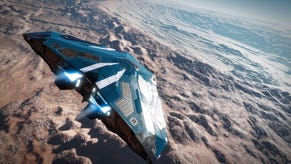Elite Dangerous - how to choose the best ship and upgrade it
Everything you need to know about all the ships available in Elite Dangerous, and how to keep them upgraded and insured in the early days.
More ships are planned for future updates to Elite Dangerous, but at launch there's something to suit most budgets and professions. Here's a quick look at the most significant ships currently available, how each one fares within its category, and what you might want to work towards next.
We'll also explain how to upgrade each craft, and stay on top of the game's retroactive insurance system.
Multi-purpose ships
Sidewinder
The all-rounder starting ship, good for sampling lots of different activities in the game without inviting disaster upon your credit balance. While it's not the most powerful ship in the game by a long shot, it is one of the most agile, giving even the greenest pilot an edge when dogfighting.
Adder
The Adder represents the halfway house between the default Sidewinder ship and the beefier Cobra Mk III. Not only does the Adder have a great jump range for exploration fans, its cargo-hold can also be upgraded to turn the ship into a decent transporter too.
Cobra Mk III
If you want to smuggle your ill-gotten gains from one part of space to another, you can do a lot worse than the Cobra. It's low heat signature will keep the police at bay, while its decent cargo capacity ensures you make efficient use of your time. A decent weapons system rounds off the package.
Imperial Clipper
The Imperial Clipper is one of the most powerful all-rounder ships in Elite Dangerous. To purchase it, you'll need to have achieved either the Empire rank of Baron or better with the Imperial Navy, or achieved Allied status with the faction the base owner is connected with.
Combat ships
Eagle
The Eagle is a very popular combat ship for those starting out their career as a Bounty Hunter, although you should invest in better shields as soon as you have the funds to do so, as the hull is a little lightweight.
Viper
The Viper is good enough for the authorities to police space with, so it should be good enough for you too. On the negative side, the Viper burns through both fuel and power like nobody's business, so don't expect to carry much with you when you leave the Station.
Federal Dropship
If you want to fly the Federal Dropship you'll need to first attain the rank of Ensign or better with the Federation, and find 40 million or so credits from behind the back of the sofa.
Python
The Python can go up against an Anaconda if it's flown by the right pilot, but given the high cost of fitting out this particular ship it's a brave or rich player who opts for one of these in combat.
Anaconda
The Anaconda is pretty much the end-game as far as combat ships are concerned in Elite Dangerous. It's massive and armed to the teeth, but you'll need to bring around 150 million credits to the table if you want to fly one of these beauties.
Transport ships
Hauler
As the name suggests, this clunky machine is best at shipping goods from one section of the galaxy to another. Note that it is extremely limited in combat, so be prepared to run rather than stand your ground. The cargo hold can be expanded from the default eight to 22 slots.
Lakon Type-6 Transporter
The Lakon Type-6 is a pure trading and hauling vehicle. The relatively high purchase cost (approximately one million credits) means you'll be hauling goods for some time before you get to set foot in it though.
Lakon Type-7 Transporter
Like the Type 6 but bigger, and capable of putting up a bit more of a fight in space. The logical next step for those who've been grinding out the credits in a Type 6.
Lakon Type-9 Heavy
You might have spotted a pattern emerging here. The Lakon Type-9 represents the last and best in the Lakon line - for now at least - and boasts the biggest cargo hold currently available in the game.
Exploration ships
Asp Explorer
As you can probably guess, the Asp is a great choice for those who need to sail across particularly wide gulfs of space. It's got a fantastic jump range (particularly when it's been upgraded), and its fuel capacity will keep you on the road for yonks.
Upgrading ships in Elite Dangerous
You can make various upgrades to your ship in the Outfitting section of the Station Services interface. How exactly you choose to kit out your ship will depend very much on the activities you have planned, and how much cash you have in the bank to complete the upgrades.
With that said, if you've managed to grab yourself a shiny starter ship - and still have a little extra cash floating around - we recommend checking out some of the new players fits detailed over at the Bark and Byte blog. You may have to shop around to find some of the specific upgrades suggested, but tech-based economies are usually a great place to grab all the ships and items you need.
How insurance works in Elite Dangerous
Insurance isn't quite the right word for the reimbursement system in Elite Dangerous, but it's the one used by the developers and community so we'll stick with it. Should you be unfortunate - or daft - enough to get your ship accidentally exploded, you'll be given the choice to buy it back by spending an insurance premium of 5%. This expense comes after you've lost your ship, however.
When buying a ship, you should always see its premature expiration as an inevitability, and assume that you'll lose it before you can make your investment back. In other words, make sure you always have enough money left to rebuy the ship at 5% cost (after any cargo you've stuffed in your hold), otherwise you run the risk of being unceremoniously dumped back into a starting Sidewinder.
You can find the rest of our Elite Dangerous guide from the first page of this article.









